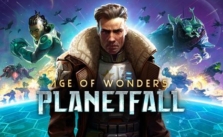Age of Wonders: Planetfall – The Star Union

The founding of the Star Union
The Star Union originated from a federation of human colonies that emerged in the early ages of humanity’s colonization of space after the discovery of the natural occurring spatial rifts. Once stabilized, these rare connection points to the Void allowed humans to reach distant worlds with faster than light travel.
The founders, the first of the so-called Star Holders, established peace and cooperation among the formerly rivalling colonies, despite their varying cultures and interests. They developed specialized ships and navigation techniques for travelling through the Void, setting up a network of supply stations and communication arrays along the rifts, commonly known as the Nexus. The first of the Star Holders reached saintly status. In this early stage, the Union covered a couple dozen colonies and was commonly known as the Federal Star Union. At a certain point the humans had explored and settled most regions of space the more stable Void torrents could lead to, resulting in a long era of consolidation.
The dawning of a new age began when scientists discovered a way to artificially create spatial rifts. Launching sub-FTL ships carrying massive Gravity-Bombs, G-Bombs for short, opened additional rifts in systems with resource rich worlds. Once connected to the Nexus, these bridgeheads led to the discovery of further natural rifts and the Union’s extension started to explode as new areas of space were discovered and charted each day. During that time, first contact was made with a sentient alien life form, a race called the Kir’ko, which the Union eventually subjugated.
The Star Holders and the CORE
To guard the interests of the colonies and humanity at large, the Star Holder was surrounded by a cabal of human advisors called the Circle; each entrusted with a certain area of human life. At first, these advisors were emissaries from individual colonies and the various religions, but gradually Circle Membership was reserved to include only the leaders of the mega-corporations of the empire, such as the Terratech Terraforming Company or Paragon Augmentations labs.
As the Star Union grew from dozens to thousands of worlds, the Union deployed a governance system at the heart of the Nexus called CORE (short for Conscientious Omnipresent Regency Engine), which gathered and processed data from across the Union. At the start of their term, Star Holders would be connected to CORE, opening their minds to the immense interstellar dataflow. At first, the wet wiring of the Star Holders into CORE was primitive, with some of them dying from infections or brain damage. But as the CORE technology advanced, it allowed the Star Holders to make an unfathomable amount of decisions per second, up to the point that it wasn’t apparent anymore which of those decisions were actually still made by the Star Holder’s consciousness and which by the CORE supporting AIs. Still, to the populace, these Star Holders seemed so powerful, they were declared Emperors.
Rippling effects
This widening gap in society was not the only problem the Star Union had to face.
For each G-Bomb set off, a gravitational ripple was sent through the Void, like a rock making a splash in a pool. It changed the nature of the void torrents connecting the spatial rifts, making the predictions of their already inherently erratic flow more unreliable as the number of rifts increased. Sometimes entire worlds ended up disconnected from the rest of the Union, when only one of the two travel directions — entering or leaving the system — remained viable. Attempts to fight this degradation with controlled detonations of further G-Bombs in carefully calculated locations were merely temporary fixes, speeding up the process in the long run.
This development marked the end of a policy of expansionism that had so confidently relied on an unlimited supply of new worlds to claim and exploit. With the vastness of the universe slowly slipping out of reach, the internal problems of the Star Union became more and more apparent, especially so at the fringes of the Union where hyperspace travel had become the most dangerous.
The outworlds
These unstable borderland worlds, where Void Storms raged in space and ships became stranded or disappeared in the Void on a daily basis, became home to the Outlanders, a diverse group consisting of all kinds of outcasts, criminals, adventurers, environmentalists, freedom fighters and followers of forbidden religions or cults. And of Psionics, a rare type of person, who has the ability to communicate telepathically and manipulate matter with the powers of the mind. While Psionics had appeared throughout the history of the Star Union, their numbers and newly developed abilities, which always had been theorized to be connected to Void travels, seemed to thrive in the unstable environment provided by the Outworlds.
In the eyes of the Star Union, these separatist and individualist tendencies could only be regarded as a threat and the resulting attempts to keep control over the vast region of space covered by the Outworlds led to a further militarization of the empire. Soon enough, some of the Outworld colonies found themselves in a de facto state of war with the Union, struggling for independence and control over planets, people and resources.
The collapse and rebirth
After the Collapse, clusters of stars at the heart of the Union ominously disappeared and gravitational storms made travel through the Nexus impossible. The surviving factions were marooned on the outer frontiers of the Union, light years apart. During this Dark Age, new factions formed on these remote worlds. Centuries of separation made brothers and sisters aliens to one other. As the storms started to subside, the factions prepared to meet each other, all vying to rebuild an empire according to their own ideals and trying to find out what happened to the Star Union.


